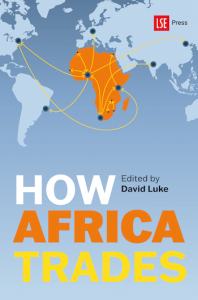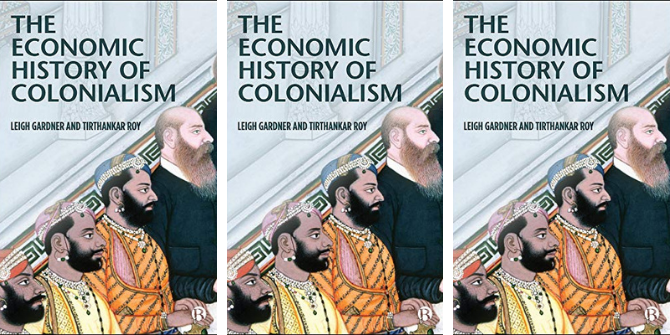In How Africa Trades, editor David Luke and the volume’s contributing authors take a forensic look at Africa’s trade, from relationships with the World Trade Organization and efforts to boost intra-African trade to the rise in e-commerce since the Covid-19 pandemic. This is an excellent, eye-opening examination of the conditions shaping the continent’s trade and emerging trends, writes John Struthers.
How Africa Trades. David Luke (ed.). LSE Press. 2023.
 I was delighted to undertake a review of David Luke’s recently published edited book How Africa Trades. This was partly to do with the intriguing title which invites the reader to dissect the official data on African trade to uncover some surprising trends behind the published statistics. Across eight chapters, Professor Luke and the chapter authors adopt a forensic approach to try to understand in more detail why Africa, given its size and economic importance, does not contribute more to global trade.
I was delighted to undertake a review of David Luke’s recently published edited book How Africa Trades. This was partly to do with the intriguing title which invites the reader to dissect the official data on African trade to uncover some surprising trends behind the published statistics. Across eight chapters, Professor Luke and the chapter authors adopt a forensic approach to try to understand in more detail why Africa, given its size and economic importance, does not contribute more to global trade.
The existing literature often spotlights the following features of African trade: a heavy dependency on primary commodities including minerals, oil and fuel; the low value added to African exports due to inefficient supply chains and unfair value chains; the low contribution that African exports make to global trade, especially in manufactured products; and the low levels of intra-African trade, the latter despite the existence of Regional Economic Communities (RECs) in Africa which were established to increase levels of intra-African trade as much as to increase African exports across the globe.
The level of intra-African trade in recent years has seen good levels of growth in manufactured goods.
In fact what we find in How Africa Trades, somewhat surprisingly, is that the level of intra-African trade in recent years has seen good levels of growth in manufactured goods. By 2020, manufactured goods traded between African countries were, according to the authors’ own calculations, 45% of intra-African trade, with trade in food accounting for about 20%. Yet, Africa still lags behind other continents in terms of overall intra-continental trade. The authors attribute this to a range of factors: poorly developed border infrastructure; unwieldy (and expensive) customs arrangements; the prevalence of costly non-tariff barriers (NTBs) and non-tariff measures (NTMs); and lack of compliance on trading standards such as Rules of Origin and Sanitary and Phytosanitary Standards (SPS).
The authors present some interesting data on overlooked trends such as the growth in the export of services across the continent.
Against this background, the authors present some interesting data on overlooked trends such as the growth in the export of services across the continent, a phenomenon rarely cited in other works on African trade. Over the period 2005 to 2019, Africa’s services exports grew from circa US$ 60billion to over US$120 billion, although in 2020 this fell dramatically back to just over US$80 billion, most likely due to the COVID-19 crisis. Nevertheless, Africa’s share of world services exports remained pitifully low at around 1.75% in 2020, down from 2.3% in 2010.
The chapter which discusses the creation of the African Continental Free Trade Area (AfCFTA) in 2018 is particularly insightful as it sets out the laborious negotiation process(es) designed to knit together such an ambitious free trade area across so many member countries. The plans are rightly ambitious, especially when it comes to much-needed infrastructural development across the continent to enable easier transport access to African markets, although this is only one among many of the different aspects of the AfCFTA discussed in the book.
[AfCFTA sets out] much-needed infrastructural development across the continent to enable easier transport access to African markets.
Another very interesting chapter is concerned with Africa in the World Trade Organization (WTO). Here, the well-known narrative of low levels of effective participation by African countries in the WTO, especially the smaller ones, is reiterated. The authors attribute this to a paucity of expertise in areas such as trade policy, facilitation, and negotiation among African member countries. This is most pronounced in the area of dispute resolution and settlement. The authors note the possible benefit of pooling expertise and resources among African countries via the African Group in Geneva and an increased role for the African Union (AU). Looking ahead, a key question will be how (and at what level) the AfCFTA will work alongside the WTO. With such a plethora of trade-related institutions and organisations speaking up for Africa, is there not a danger of overlapping missions and objectives?
The ability of African countries to respond to the pandemic took various forms to ensure ‘safe trade’ practices that were compliant with cross-border health measures.
No book with the title How Africa Trades would be complete without a section or chapter on informal and digital trade. Here, it is framed in terms of the impact of COVID-19 on these aspects, and the chapter contains some important insights. The ability of African countries to respond to the pandemic took various forms to ensure “safe trade” practices that were compliant with cross-border health measures. The chapter provides examples of these which support the view that African businesspeople, traders, and exporters are resilient, entrepreneurial and resourceful. An example mentioned in the chapter in response to the COVID-19 pandemic was the way some informal traders aggregated or “pooled” their consignments to cut down on the number of individual consignments of goods traded across borders.
To conclude, I turn to the title of the final chapter written by David Luke: ”It is in the world’s interest to give Africa a new trade deal…” I have put the word “give” in italics as it is perhaps the only sentiment in the whole book that I might wish to dissent from. Later on the same page, Professor Luke qualifies the intended meaning by referring to the need for organisations like the WTO to avoid a “one-size-fits-all” application of its rules. Whether this is ever likely or, for that matter, desirable is open to debate. Possibly a more nuanced view is that context is all-important, especially the African context. Trade deals arise from tough negotiations between the various parties involved, and even when the scales are so unbalanced to begin with, reciprocity must ultimately determine the outcomes of these trade deals, no matter where the starting point is.
The need for organisations like the WTO to avoid a “one-size-fits-all” application of its rules.
This is an excellent book which probes deeply into the topic of How Africa (actually) Trades. It is an eye-opener for those academics like me who pore over official trade statistics on Africa but usually with an emphasis on what Africa trades rather than how. I will certainly recommend it to my students.
Note: This review gives the views of the author, and not the position of the LSE Review of Books blog, or of the London School of Economics and Political Science.
Main Image: shynebellz on Shutterstock.







